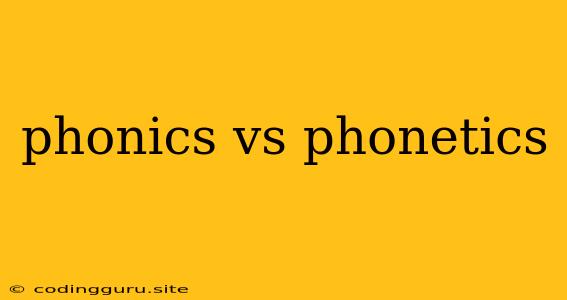Phonics vs. Phonetics: Understanding the Difference
The terms "phonics" and "phonetics" are often used interchangeably, leading to confusion among learners. While they are closely related, they represent distinct concepts within the realm of language and speech. Understanding the differences between phonics and phonetics is crucial for effective language learning, especially for literacy development.
What is Phonetics?
Phonetics is the scientific study of speech sounds, encompassing their production, transmission, and perception. It focuses on the physical aspects of speech, examining how sounds are created by the vocal organs, how they travel through the air, and how they are interpreted by the listener's ear and brain.
Key aspects of phonetics include:
- Articulatory phonetics: Examines the physical movements of the mouth, tongue, and other speech organs involved in producing sounds.
- Acoustic phonetics: Studies the sound waves produced by speech and their physical properties.
- Auditory phonetics: Investigates how the human ear and brain process and interpret sound.
Phoneticians use a system of symbols called the International Phonetic Alphabet (IPA) to represent and transcribe sounds. The IPA provides a standardized system for accurately representing sounds across languages, regardless of spelling.
What is Phonics?
Phonics, on the other hand, is a method of teaching reading and writing based on the relationship between sounds and letters. It focuses on the sounds that letters make and how these sounds combine to form words. Phonics instruction helps learners decode words by recognizing letter-sound correspondences and blending these sounds together.
Here's how phonics works:
- Letter-sound relationships: Phonics teaches learners to identify the sounds associated with individual letters and letter combinations. For instance, "c" can make the /k/ sound in "cat" or the /s/ sound in "cent".
- Sound blending: Phonics helps learners combine the sounds of individual letters to read unfamiliar words. For example, by blending the sounds /k/, /a/, and /t/, a learner can decode the word "cat".
- Decoding and encoding: Phonics skills are essential for both reading and writing. Decoding allows learners to read words, while encoding helps them spell words by understanding the sounds they represent.
The Key Difference: Theory vs. Practice
The fundamental difference between phonics and phonetics lies in their focus:
- Phonetics is the scientific study of speech sounds, examining their production, transmission, and perception. It provides a detailed understanding of how sounds are created and perceived.
- Phonics, on the other hand, is a teaching method that utilizes the knowledge of phonetics to teach reading and writing. It focuses on applying the principles of phonetics to the practical task of decoding and encoding written language.
An Analogy:
Imagine a mechanic who works on cars. They understand the inner workings of an engine (phonetics), but their ultimate goal is to fix a broken car (phonics).
How are Phonics and Phonetics Related?
Phonics relies heavily on the principles of phonetics. A solid understanding of phonetics provides the foundation for effective phonics instruction. By understanding the sounds of language and how they are produced, teachers can create effective phonics programs and materials.
Examples of How Phonics and Phonetics Work Together:
- Recognizing vowel sounds: Phonetics helps understand the different vowel sounds, such as the short /a/ sound in "cat" and the long /a/ sound in "cake". This understanding informs phonics instruction, teaching learners to identify and differentiate these sounds.
- Identifying consonant digraphs: Phonics teaches learners to recognize letter combinations like "sh" and "ch" that represent single sounds. This knowledge is built upon the phonetic understanding of these sounds and how they are produced.
- Understanding spelling variations: Phonetics helps explain why the same sound can be represented by different spellings, such as the /f/ sound in "phone" and "graph". This understanding helps learners develop flexibility in reading and writing.
Conclusion:
Phonetics and phonics are intertwined concepts that are essential for language learning. While phonetics provides the scientific foundation for understanding speech sounds, phonics applies this knowledge to the practical task of teaching reading and writing. Both are crucial components of a comprehensive language development program.
